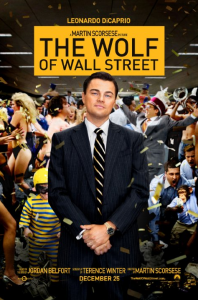
 After the elegant artistry that marked “Hugo,” director Martin Scorsese goes decidedly low rent with “The Wolf of Wall Street,” a film that is purportedly based on a true story. This indulgent and wildly over-the-top romp is something you would expect from a younger and lesser disciplined director. After about an hour and a half of entertaining set up, “Wolf” devolves into a cesspool of nonsense and unfocused narrative threads that ultimately matter little.
After the elegant artistry that marked “Hugo,” director Martin Scorsese goes decidedly low rent with “The Wolf of Wall Street,” a film that is purportedly based on a true story. This indulgent and wildly over-the-top romp is something you would expect from a younger and lesser disciplined director. After about an hour and a half of entertaining set up, “Wolf” devolves into a cesspool of nonsense and unfocused narrative threads that ultimately matter little.
“The Wolf of Wall Street” is based on the true story of Wall Street broker Jordan Belfort, whose rise and fall in the industry is one of legend. Less a cautionary tale and more of a how-to manual, Scorsese works from a screenplay by Terence Winter (“Boardwalk Empire”) that is an adaptation of a book by Belfort himself. In the 1990s, Belfort was a notorious stock swindler who now owes restitution in excess of $100 million to his victims.
Sadly, instead of humanizing Belfort and explaining how a promising mind can become so corrupted, Scorsese chooses to glorify the corruption. While Belfort, played by a completely unhinged Leonardo DiCaprio, does some crazy things over the course of the narrative, he is never depicted as being uncool. The love affair that the film has with its subject clouds what should be an otherwise realistic closing act showing the effect of so much greed and excess on a human being. For example, this guy, Belfort, was addicted to all manner of drugs, and yet the film ends with the suggestion that he has no ill effects from such addictions whatsoever.
The only real characters in the film are a government agent played by Kyle Chandler and Belfort’s father, played by an extremely amusing Rob Reiner. Unfortunately, the movie, clocking in at close to three hours, does not give Chandler or even Reiner enough development. Instead of giving us any meaningful character development, Scorsese would rather spend an eternity focusing on sex and drug use. One scene has Belfort taking some kind of powerful Quaalude and becoming disabled to the point where he must crawl to his expensive sports car. Not only is this scene agonizingly slow but it really serves very little narrative purpose. Sequences like this take on a sophomoric quality that is reminiscent of two guys in a bar trying to impress each other with wild stories of depraved drunken debauchery.
Comparisons to Scorsese’s classic works like “Goodfellas” are misplaced. DiCaprio’s Belfort is never more than a parody of a real human being, and, therefore, the audience cannot connect with him. Compare Ray Liotta as Henry Hill in “Goodfellas” where, even though he was a bad guy, we still liked Henry and wanted him to succeed. Perhaps mobsters are just more honorable than Wall Street brokers. It really doesn’t matter because whatever Scorsese is up to falls horribly flat as the film wears out it’s welcome in its last hour.
One thought that I had after watching the film was whether this subject deserved such grand Hollywood treatment. It is one thing to make a movie about a bad person, but it is another to focus so much on the bad guy that it almost makes him notoriously cool and someone to be emulated. Like “The Armstrong Lie” that I reviewed earlier this month, I wonder whether or not films like “Wolf of Wall Street” irresponsibly focus on the monster instead of the victims. After all, many little guys lost their life savings because of Belfort’s wrongful acts. Scorsese gives us little of that context and instead suggests in the end that crime does pay. And if your crime is hip enough, you might just get your own movie starring Leonardo DiCaprio.
